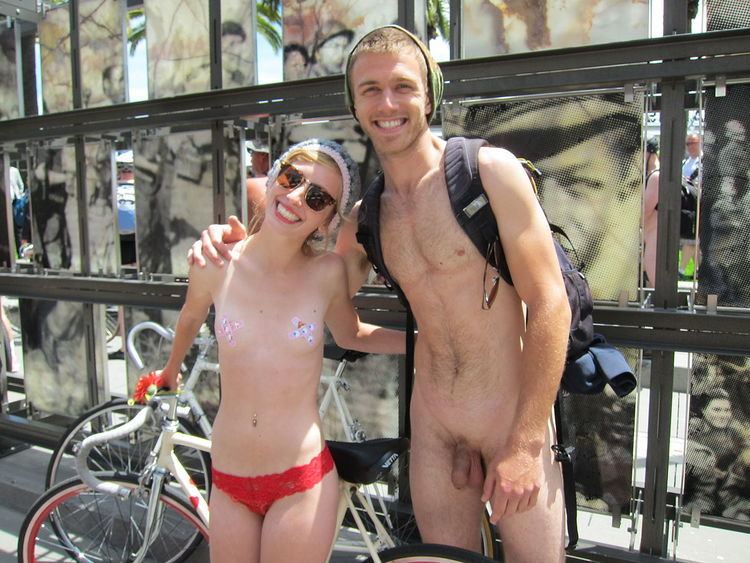 | ||
San Francisco for over a century, allowed unrestricted public nudity. The city opted to regulate it in a 2012 decision by requiring a police-issued parade permit for such displays of public nudity. Indeed, repeat offenders were criminalized. This decision received some national press coverage.
Contents
Legality
The California Supreme Court, in of In Re Smith (1972), held that sunbathing on an isolated beach was not lewd. In subsequent cases that principle has been upheld and extended. There is a rarely enforced anti-nudity civil ordinance in the parks of San Francisco, including Golden Gate Park. This was put in place in 1970 in response to hippies dancing nude in a circle every Sunday in Speedway Meadow in Golden Gate Park.
In 1969, Carol Doda began go-go dancing bottomless at the Condor Club on Broadway and Columbus in North Beach (she had been dancing topless at the Condor since 1964). Soon nude dancers began dancing at various clubs in North Beach. Three gay bars featured nude go-go dancing between 1969 and 1972. However, because of complaints, in the summer of 1972, California banned nudity in places that serve alcohol.
In September 2011, nudists gathered to protest a proposed ordinance that would put some restrictions on public nudity in San Francisco. This ordinance was superseded in December 2012 by a ban on public nudity in San Francisco, proposed by Scott Wiener. The ordinance passed on November 20, 2012 by a 6-5 vote by the Board of Supervisors was Ordinance 234-12.
The passage of the ordinance received some national press coverage.
A suit to block the ordinance was rejected by a federal judge.
As of 2013, public nudity without a parade permit is illegal in San Francisco according to SF Police Code § 154 (under Article 2: Disorderly Conduct).
Specifically, subsection e of the ordinance, which criminalizes nudity and makes it a possible misdemeanor, reads:
e. Upon the third or subsequent conviction under this Section 154 with in twelve months of the first violation, such person shall be guilty of an infraction or a misdemeanor. The complaint charging such violation shall specify whether, in the discretion of the District Attorney, the violation is an infraction or a misdemeanor. If charged as an infraction, upon conviction, the violator shall be punished by a fine not to exceed $500. If charged as a misdemeanor, upon conviction, the violator shall be punished by a fine not to exceed $500 or by imprisonment in the County Jail for a period not to exceed one year or by both such fine and imprisonment.Beaches
San Gregorio Beach, 20 miles south of San Francisco, was the first official nude beach in America in 1967. The San Francisco Bay Guardian published a clothing optional beach guide to California annually.
Within San Francisco city limits are three clothing optional beaches:
Urban commons
In 2010, Rebar, which creates parks out of public spaces, created a park/plaza in the Castro District at 17th/Market/Castro. It was named "Jane Warner Plaza", after the policewoman who used to patrol the Castro. Activists for social nudity began congregating there, resulting in complaints to the police.
Events
There are many long-time established clothing optional events in San Francisco including:
Athletic
Biktivism
Costume
Gay pride and fetish
Activists
Some of the activists for social nudity in San Francisco were Lloyd Fishback, Rusty Mills, Rocky Angel, George Davis, "Nude Woody", Tortuga, Gypsy Taub, "Naked Marvin", Rich & Julie Pasco, Erik, SaraKay, "Bare", Mickey, Mikal, WNBR San Francisco organizers, Gerry West, C.J., Ross, and many others. In newspaper reports, these people are generally referred to as the "Castro nudists".
Nudists were active in some neighborhoods in San Francisco besides the Castro, including the Haight-Ashbury, Union Square, Fisherman's Wharf as well as the Mission. Some nudists who live in San Francisco will go about their daily activities nude no matter where these activities take them. These nudists maintain that the push for body acceptance and body freedom is in no way sexual or prurient. Nudists believe that shame, fear, and the view that the human body is always sexual or obscene are ideas which are socially constructed and learned, just like any other prejudice or bigotry. Nudists assert that simple, healthy, social nudity harms no one. A recent Zogby poll showed the 60% of Californians stated that they were not personally offended by the non-sexual nudity of others.
Nudity ban protests
On Saturday, November 17, 2012, some of the Castro nudists gathered in front of San Francisco City Hall to protest the proposed ban on nudity. The ordinance was passed on November 20, 2012, and went into effect on February 1, 2013, after a federal judge heard and rejected an appeal to suspend the ordinance. A protest held on February 1, 2013, on the steps of the San Francisco City Hall ended with four nude protesters being detained, taken to Northern Police Station, cited for public nudity, then released. The police did not take the four protesters (Gypsy Taub, Trey Allen, George Davis, Dany Devero) into the station building but instead kept them in the police van parked inside the police open air garage. The four protesters were released from the vehicle, cited, and then given blue blankets to cover their body as they were taken from the scene of City Hall without their belongings. The Castro nudists were suing because they asserted that the ordinance violates what they call their constitutional right to be nude in public.
Depiction in culture
On September 21, 2012, a short play entitled The Buck Naked Church of Truth, produced by the Left Coast Theatre Company, premiered in San Francisco. The comedy, by James A. Martin, addresses the public nudity debate in the city by depicting a father who discovers his son naked in the Castro.
